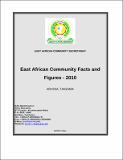East African Community Facts and Figures 2010
Author
Date
2011-03Type
Reportviews
downloads
Metadata
Show full item record
Abstract/
The EAC Facts and Figures Report presents empirical data of socio-economic indicators in the region from which trends of development and growth levels can be analyzed. Findings indicate that EAC midyear population was estimated at 129.5 million by June 2009 with average annual growth rate of 2.5 percent down from 2.8 percent in 2007. Infant mortality rate in the region ranges from 52 to 106 while child mortality rate ranges from 74 to 137. Both mortality rates are generally on a declining trend while in the education subsector, most indicators - including enrolment, completion, transition and literacy rates - showed improvements. On economic performance, the EAC recorded decelerated average real growth rate of 4.7 percent in 2009 compared to 7.0 percent in 2008. Rwanda recorded the highest real growth of 6.1 percent, followed by Tanzania and Uganda at 6.0 and 5.2 percent, respectively. In aggregate, total GDP for the region amounted to US$ 74,047 million in 2009, compared to US$ 72,998 in 2008.The dominant sector in all the partner states in 2009 was agriculture, followed by wholesale and retail trade and manufacturing The average annual underlying inflation rate for the EAC dropped sharply from 12.8 percent in 2008 to 6.6 percent in 2009. In public finance, the ratio of Tax revenue to GDP varied from 12.1 percent (in Rwanda) to 23.4 percent (in Kenya). The tourism sub-sector experience a rebound, with visitor arrivals growing by a modest 4.0 percent in 2009 compared to a decline of 7.4 percent recorded in 2008. On average, there seems to be a slight recovery in coffee production in the last two years, while tea production has been on a declining trend over the same period. Cement consumption, a core indicator for the construction sector, has consistently been on the increase in the EAC. The data in the report was obtained from the National Statistics Offices, Central Banks of the Partner States and other government departments and targets a wide spectrum of users including policy makers, researchers, investors, academicians and development Partners.
Publisher
EACPermalink
http://hdl.handle.net/11671/206Collections
- Reports/Publications [133]

